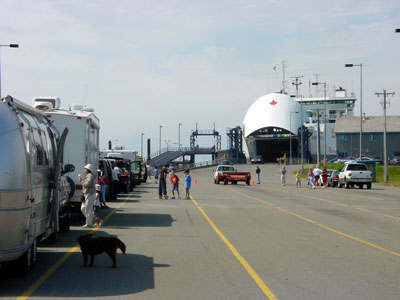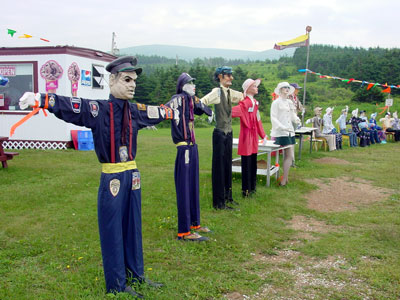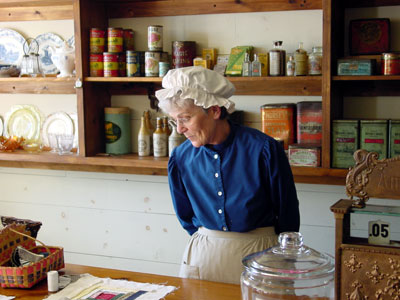
We took the ferry from Wood Islands on Prince Edward Island to Caribou, Nova Scotia rather than drive back across the Confederation Bridge and through New Brunswick to get to Nova Scotia. They have an interesting way of charging tolls for both the ferry and the bridge; they collect the toll only as you leave Prince Edward Island. The toll for the ferry is $50 and for the bridge is about $38, so it is cheaper to take the ferry to PEI and leave PEI using the bridge, but that didn't fit with our travel plans. The toll is based on the length of your vehicle; the next price up ($65) is for lengths between 20 feet and 40 feet. Our van is just under 20 ft, bumper to bumper, but is longer than 20 ft if you count the continental tire on the back. Furthermore, we had the bike rack on with bikes attached, so that brings the total length up to about 23 ft. So I was expecting to get hit for the higher toll, but they ignored all that and charged us only the lowest rate. They don't seem to be precise about the length, but merely "eyeball" it and charge accordingly. I didn't complain about their lack of precision!

Waiting in line to get loaded on to the ferry. The ferry bow swings up,
allowing you to drive into the hull.
We drove from Caribou into Cape Breton and headed up the western side of the island.

The enterprising owner of this roadside gift shop and snack bar had set up
about a hundred scarecrows to attract customers. The scarecrows came in all
sorts of styles, including world leaders. It was all very amusing, and a clever
and effective marketing tool; most people stopped, and some, including us, made
purchases.

A specialty of the Cheticamp area is hooked rugs. This woman demonstrated how
the hooking is done and then invited us to try it. It is not as easy as the
woman made it look. Cheticamp is in the Acadian part of the island, so this
woman is probably dressed in the traditional clothing of the area.

At Cheticamp you enter the Cape Breton Highlands National Park, which has
dramatic scenery of mountains coming down to the seashore. It was very scenic,
but there was a haze in the air spoiling the views to some extent.

We drove through the park to Bay St. Lawrence on the Atlantic side. We were
interested in seeing whales so we took a cruise on a 52 ft schooner that goes
out to find the whales. The whales were not very cooperative; we saw a few
spouts, but then they dove deep and could no longer be found. But the sailing
was exciting. The captain had the boat heeled over until our feet were almost in
the water. Nancy and I were near the bow and we got drenched from head to foot
by the spray. It was all great fun - at least one of us thought so.

The sunset from our campsite at Bay St. Lawrence. The "star-shaped" sun and
the greenish splotch near the bottom is an optical aberration due to the camera
lens being pointed at the sun.

The next morning we watched some fishermen checking their traps so see what
they had caught. The little "dots" in the water are floats connected by a line
to each trap.

The next stop was the Highland Village at Iona; this is a historical village
depicting the Scottish settlements in Cape Breton. It has a collection of
Scottish homes and farms from 1790 through about 1920; this lovely lady is in
the early 1900s general store. In talking with her, we learned that she is a
sixth generation descendant (MacNeil) of one of the original Scottish immigrants
that started the Scottish migration to Nova Scotia.